

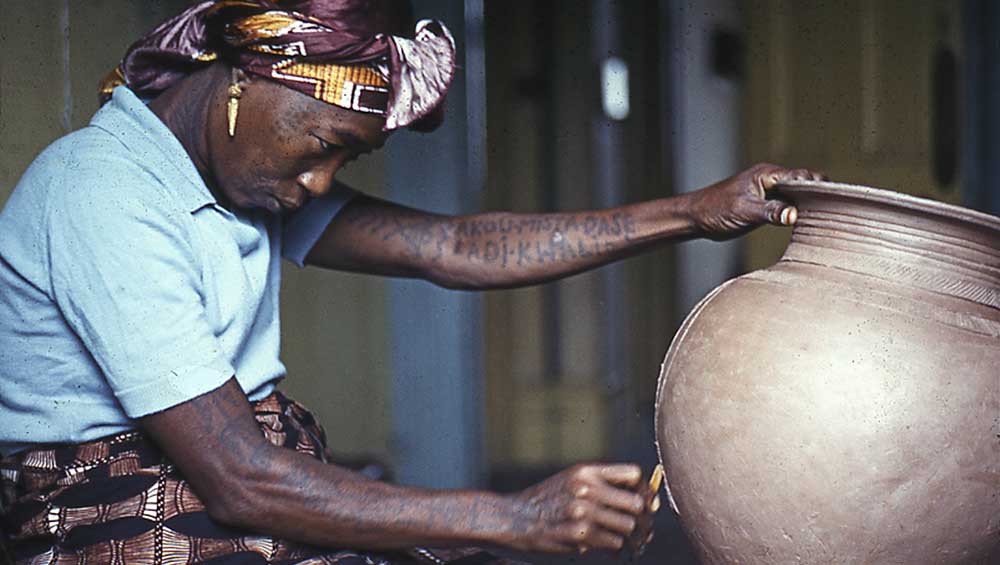
Photograph of Ladi Kwali taken by WA Ismay. Image courtesy of York Museums Trust (York Art Gallery).
Two Temple Place, London
29 January – 24 April 2022
by BETH WILLIAMSON
Body Vessel Clay is one of the most interesting exhibitions I have seen in a long time. The concept behind it must be fairly unusual as it explores how ceramics have been “disrupted, questioned and reimagined by black women” over the 70-year period from the 1950s to the present day. It is fascinating to see the visual evidence of international artistic dialogues across the decades, especially the continued importance of Nigerian women’s ceramics for contemporary artists.
The exhibition’s narrative begins with the seminal Nigerian potter Ladi Kwali (1925-84), and acknowledges the significance of the Pottery Training Centre in Abuja (now Suleja), established in the 1950s and led by British studio potter Michael Cardew (1901-83). Between 1923 and 1926, Cardew trained with Bernard Leach in England. He then set up and ran Winchcombe pottery in Gloucestershire before heading to Ghana. After spending time at Achimota College in Accra and then starting his own pottery at Vume on the Volta River, Cardew left Ghana for Nigeria in 1950 and, in 1952, the Pottery Training Centre in Abuja was established. Bringing indigenous Nigerian and British pottery together in this way caused a flash of creative rupture. Kwali, who had been hand-making coiled and pinched work in the Gwari tradition, was already admired by Cardew when she joined him in Abuja and learned new techniques that altered her work.
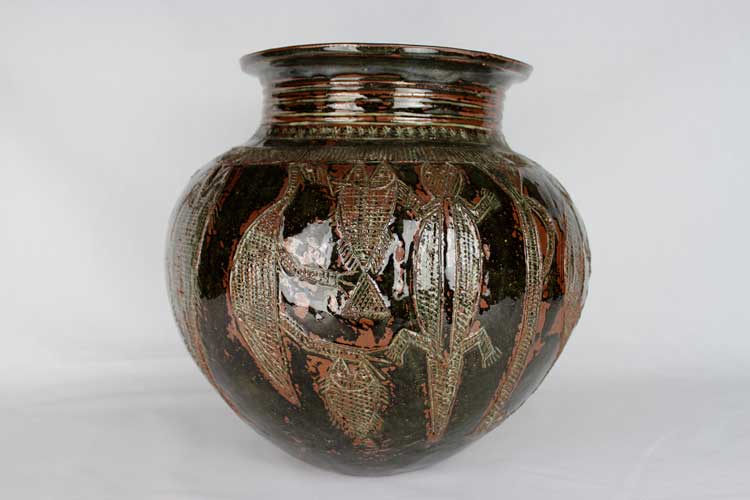
Ladi Kwali, Pot, 1959. Courtesy of York Museums Trust (York Art Gallery).
The hybrid mix of African and European influences in Kwali’s work resulted in pottery that had sculptural qualities, but retained a firm sense of the clay material used to make it. Kwali’s significance in Nigerian culture was marked when her image appeared on the 20 Naira note. The exhibition continues with the work of British-Kenyan Magdalene Odundo (b1950), who spent three months with Kwali in Abuja in 1974. Odundo learned hand-building techniques from Ladi Kwali and others. Exquisite works such as Esinasulo (Water Carrier) (c1974-76) were the result of their exchanges.
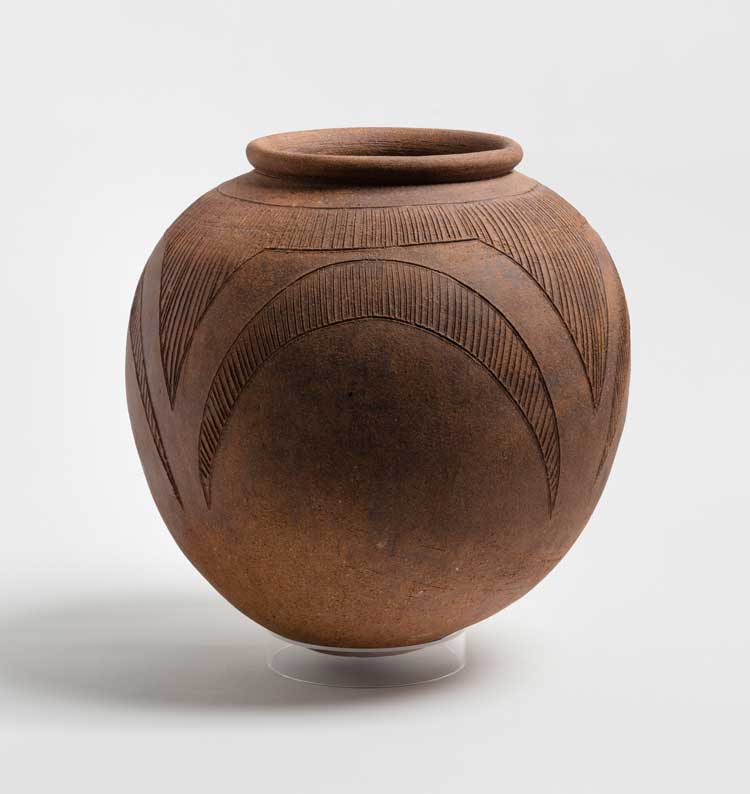
Magdalene Odundo, Water Carrier (Esniasulo), c1974-76, terracotta. © Magdalene A.N. Odundo. Courtesy The Hepworth Wakefield, Wakefield Permanent Art Collection. Photo: Lewis Ronald.
Alongside this is work by the London-based Spanish ceramicist Bisila Noha (her heritage is Spanish and Equatorial Guinean) as she directly investigates the practice of Kwali and others in works such as Two-Legged Vessel (2020). A line of influence threads from work by Kwali in the 1960s and 70s, through that of Odundo in the 80s to Noha’s contemporary practice, and “the forgotten women of clay” re-emerge in Noha’s work.
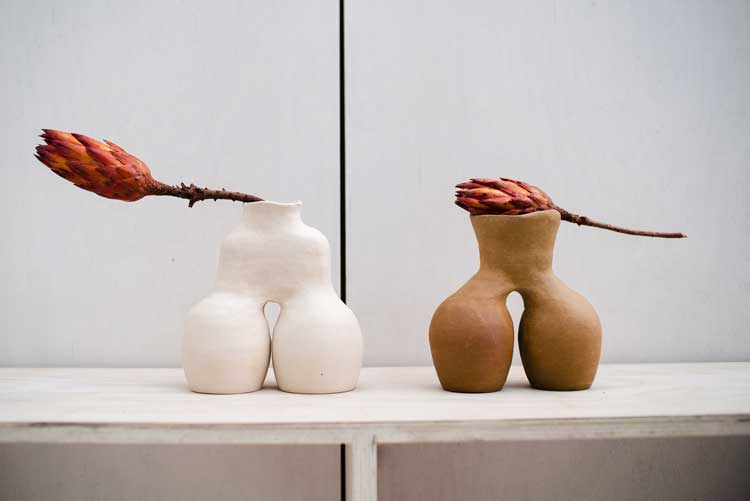
Bisila Noha, Two Legged Vessels, 2020. Courtesy of the artist. Photo: Thomas Broadhead for OmVed Gardens.
The exhibition refocuses partway through as it introduces the work of a new generation of international contemporary black female artists, all working in clay in one way or another, and all registering Kwali’s influence. It is thrilling to see how the work of one woman – Kwali – resonates across time and place and plays out in new and unexpected ways in contemporary art practice. Phoebe Collings-James, Shawanda Corbett, Chinasa Vivian Ezugha, Jade Montserrat and Julia Phillips work variously in performance, sculpture and moving image and all resonate with the legacy of Kwali.
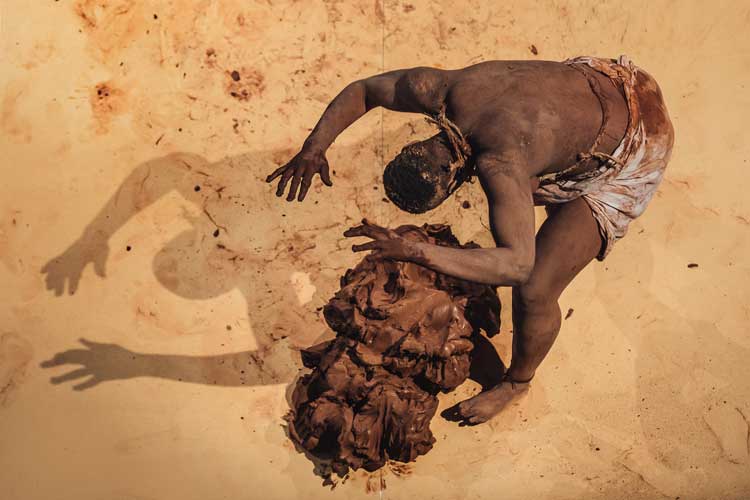
Vivian Chinasa Ezugha, Uro, a SPILL Commission at SPILL Festival 2018. Photo: Guido Mencari.
The performance Uro by Ezugha originally took place in 2018. For this exhibition, her performance is experience through photographs and new sculpture. The performance itself was an act of endurance as the artist worked with 30kg of clay over a six-hour period and photographs show her bent double supporting the weight of clay on her back. Ezugha, who was born in Nigeria and now lives in England, explores her identity through the handling of clay in a manner that raises questions of death and rebirth, of degeneration and regeneration. In this way, her Nigerian cultural heritage re-emerges in the performance through her engagement with the materiality of clay. The physical presence of 30kg of clay in this exhibition makes the photographs all the more powerful.
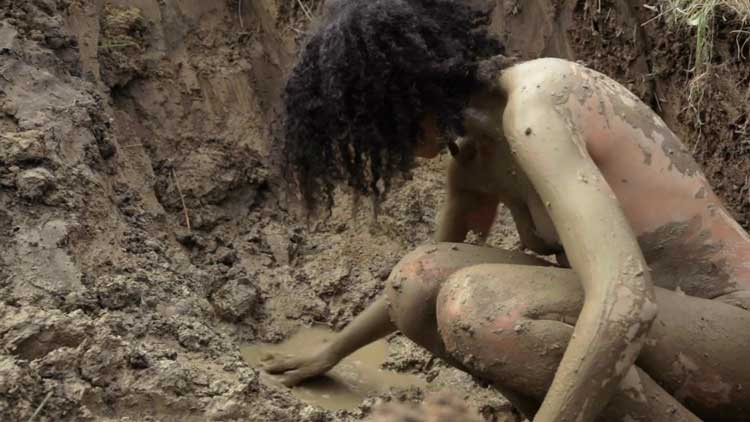
Jade Montserrat and Webb-Ellis, Clay (film still) 2015. Courtesy of the artists.
Another artist who performs with clay and the body in this exhibition is Montserrat. In her performance Clay (2015), made with the film-makers Webb-Ellis, Montserrat immerses herself in the landscape of Yorkshire, where she has lived all her life. Gouging clay from the ground with her bare hands, Montserrat partly recalls and re-enacts childhood games and mudpies. Her performance is, however, much more than that. Her naked body covered in clay, Montserrat explores ideas of belonging and race, reminding me of the work of the Cuban-American artist Ana Mendieta (1948-85) and the earth-body works of her Silueta Series (1973-80). Alongside Montserrat’s performance, we see the artist’s drawings Her Body with No Father in Sight (2017-20), bringing the legacies of colonialism sharply into view.
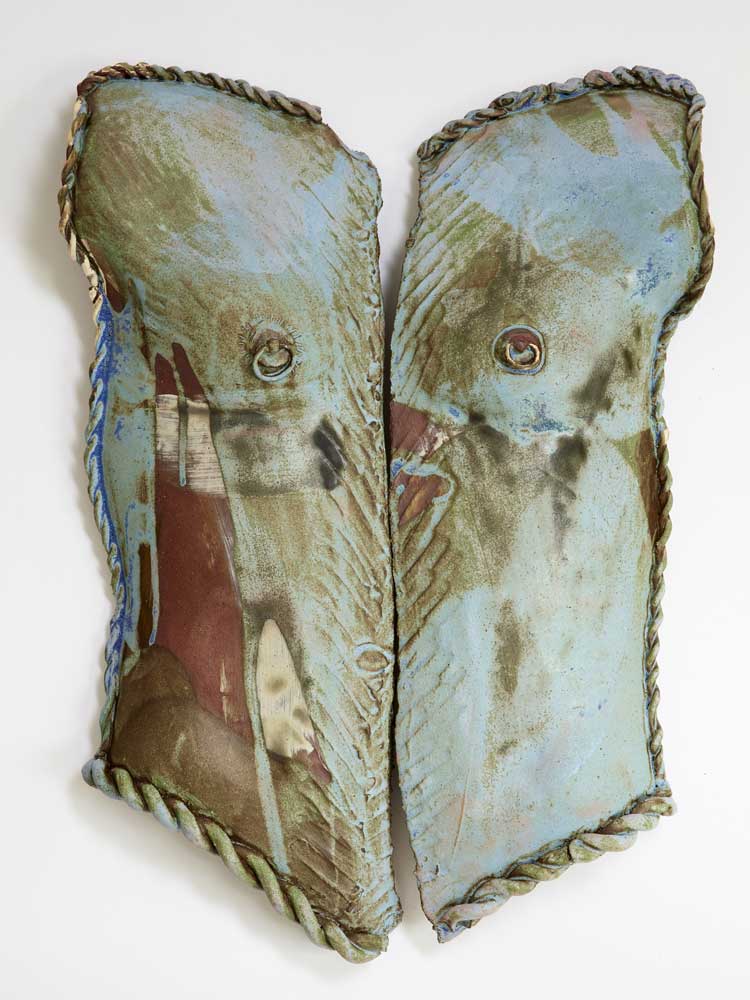
Phoebe Collings-James, The Subtle Rules the Dense, 2021. Courtesy of the artist and Camden Art Centre. Photo: Rob Harris.
After the fluid performances of Montseratt and Ezugha, Collings-James’s work is rather different. Body Vessel Clay shows three new ceramic torsos, or armour plates, from Collings-James’s ongoing series, The Subtle Rules the Dense (2021). In these works, she explores the malleability of clay and its ability to receive and hold impressions, such as the trace of the artist’s touch on its surface. As they hang in the gallery space at Two Temple Place, these clay torsos focus our attention on the tactile qualities of clay and also gesture to the gentleness of human touch, eroticism and desire.
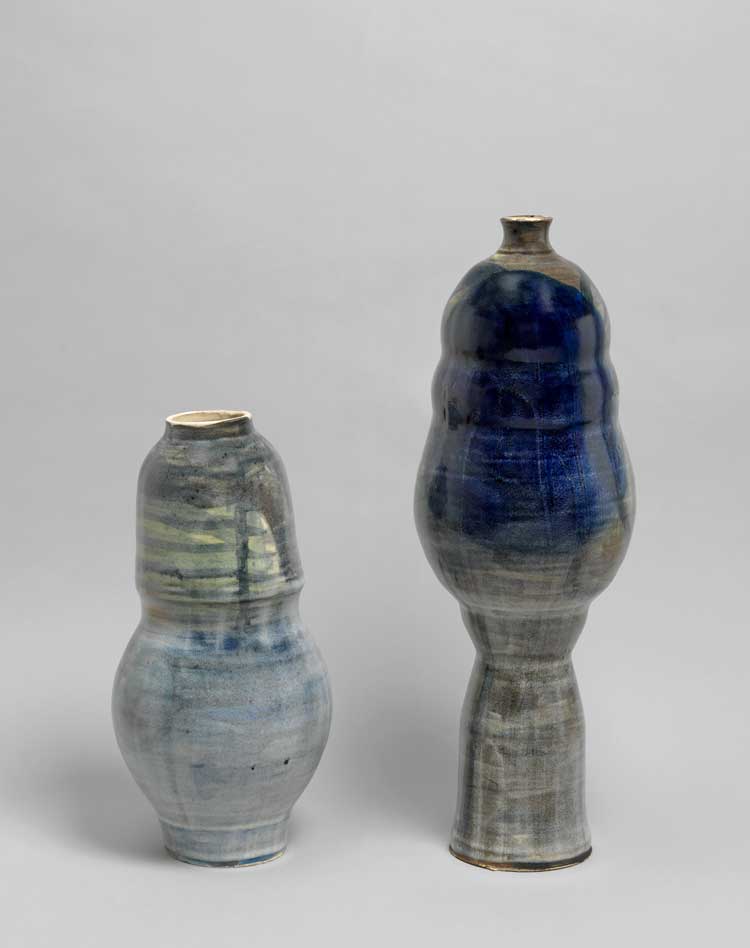
Shawanda Corbett, I’ll tell you what (From: Neighbourhood Garden), 2020, Courtesy the artist and Corvi-Mora, London. Photo: Marcus Leith.
Corbett’s vessels in this exhibition are part of her wider practice of ceramics, visual art, dance, film and performance. Corbett has had to develop her own throwing technique to make these pots, as she was born with one arm and without legs. The vessels are likened to bodies, each with its own unique shape and colour and Corbett questions the idea of a complete body and a complete vessel.
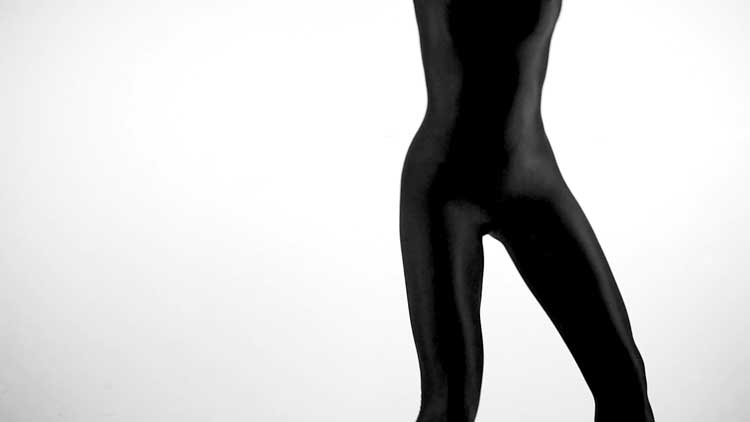
Julia Phillips, Burdened 2018, HD video loop (black and white, no sound), 57 seconds. © Julia Phillips, Courtesy Matthew Marks Gallery.
Phillips works indirectly with clay in her film performance Burdened (2018) as a stomping armless body is juxtaposed with a growing pile of mud. This is part of a wider body of work by Phillips, including ceramics and mixed media, that examine complex questions of race, gender and power. Ultimately, this, and all the works in this exhibition are concerned with the politics of clay. As Phoebe Collings-James has stated: “It was significant to know about Ladi Kwali’s work at a time when I was learning the formal techniques of wheel-throwing techniques amongst the legacy of British studio ceramics, with its overbearing colonial legacies.” Now, a new generation of black women artists turns that colonial legacy on its head, reaching back to Kwali and her peers, bringing their histories into view in contemporary practice in engaging and thought-provoking ways. This exhibition unpicks those histories and allows us to see related contemporary practice more clearly.
• Body Vessel Clay: Black Women, Ceramics and Contemporary Art will travel to York Art Gallery, 24 June to 18 September 2022.